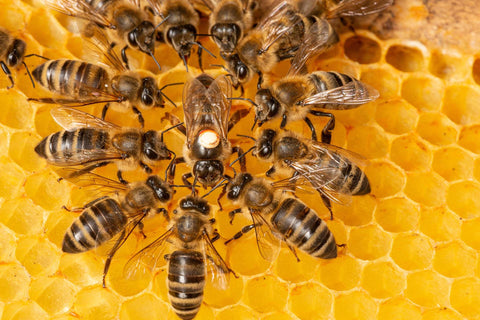Honey bees have a complex form of communication. They have an extensive pheromone system that signal different things within the hive and amongst each other. They also perform dances for each other to show locations of newfound food sources.
Pheromones
Pheromones are chemicals that are released from animals to signal different things. Each caste of the bee colony have their own set of specific pheromones used to communicate to each other.
Queen
The queen has a number of different pheromones that work together to communicate her health to the hive and also alter the workers behaviors.
The Queen mandibular pheromone is the primary communication of the queen to the hive. It prevents other worker bees from laying eggs, prevents the hive from swarming, and attracts drones during mating. When the workers cannot sense this pheromone due to the queen getting too old or the hive getting too large, the workers will begin to prepare a new queen and prepare to potentially swarm.
The queen also emits a retinue pheromone that forms a small swarm of bees around her in the hive that takes care of her. They feed her, groom her, and dispose of her waste.
Workers
Worker bees emit a pheromone, called the Nasanov Pheromone, to help foragers know where the hive is and be able to return. They will stick their abdomen in the air and fan their wings to waft the pheromone around so that foragers can follow it back.
Foragers will also emit a specific pheromone to let the hive know the ratio of foragers and as the pheromone decreases younger bees will become foragers to increase their numbers back to normal.
Guard bees that are stationed at the entrance of the hive will emit a pheromone to alert the other bees of danger. The bees that catch this pheromone will be put on alert and are prepared to sting. This pheromone is typically strongest in bees around two to three weeks old and starts to fade after that. This pheromone is found twice as much in Africanized bees and that is why they are more aggressive.
Drones
Drones release a pheromone to create drone congregation areas used for mating with queens. Drones gather in these areas
Brood
The young larvae emit pheromones to the rest of the hive to let them know whether to collect more pollen or to have bees stay as nurses to tend to the brood and cap cells when ready.
Bee Dance
Forager bees will perform a dance when they return to the hive to show where bees can go to find food sources. They walk in a figure eight pattern and waggle in the middle. The intensity of the waggle tells the quality of the source to the other bees. The size of the figure eight pattern shows how far away it is. The angle in correlation to the top of the hive shows which direction the source is. The other bees will join in if they think it is a good idea to go there and the bee dance with the most supporters is the next venture.



